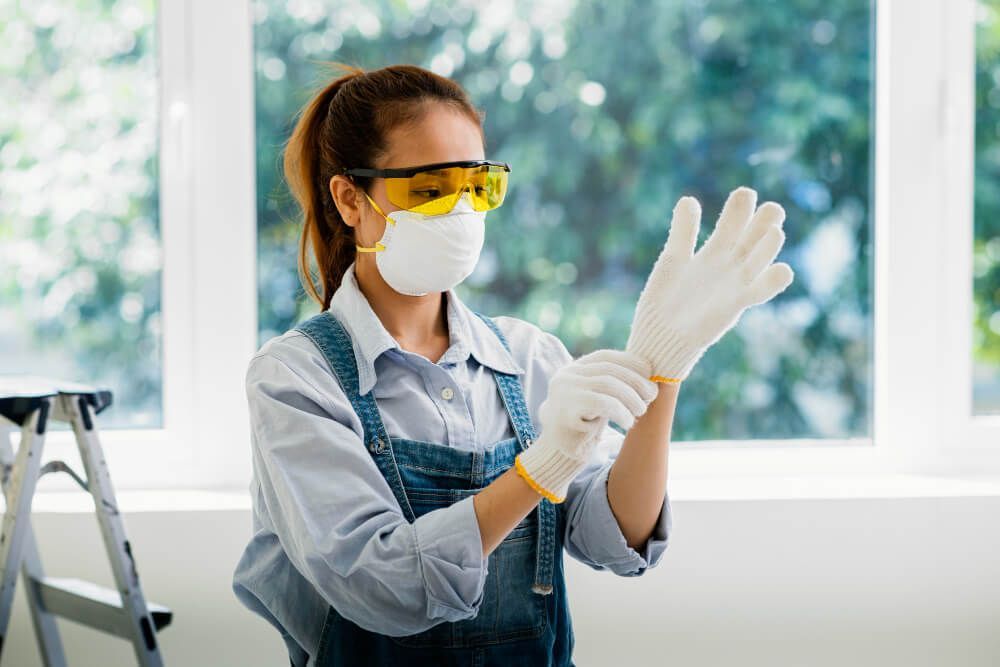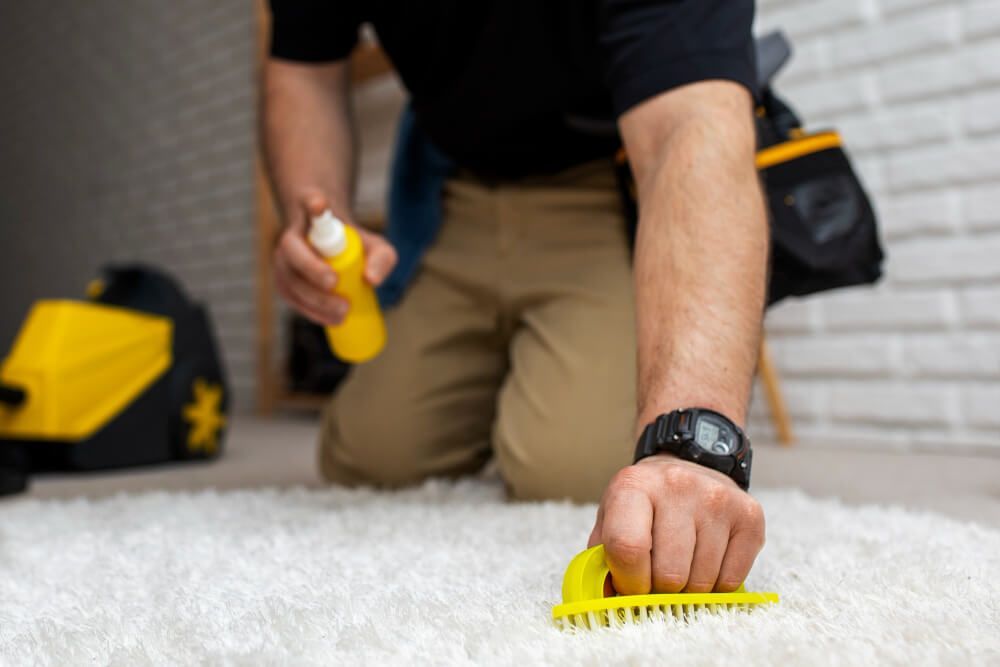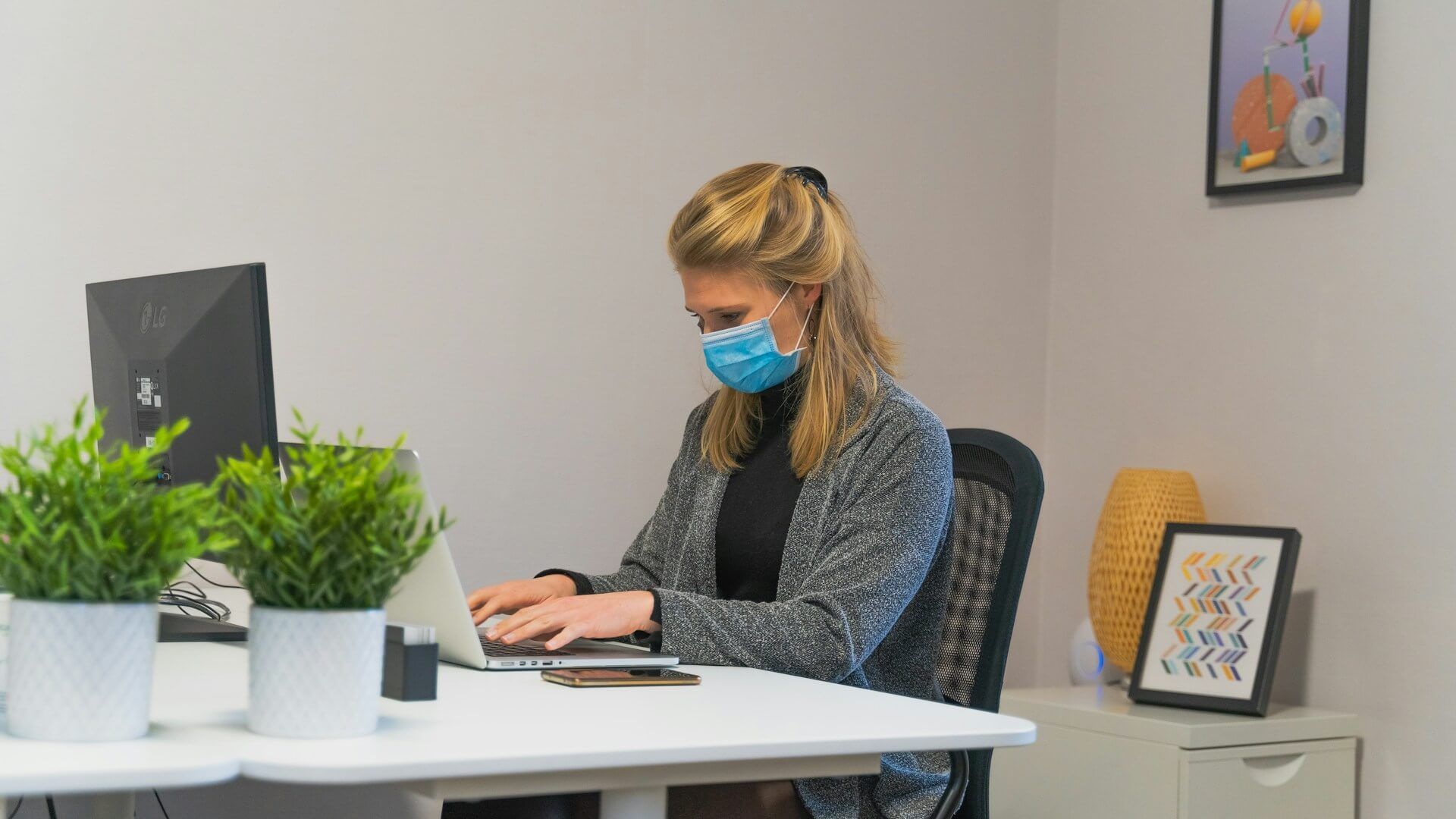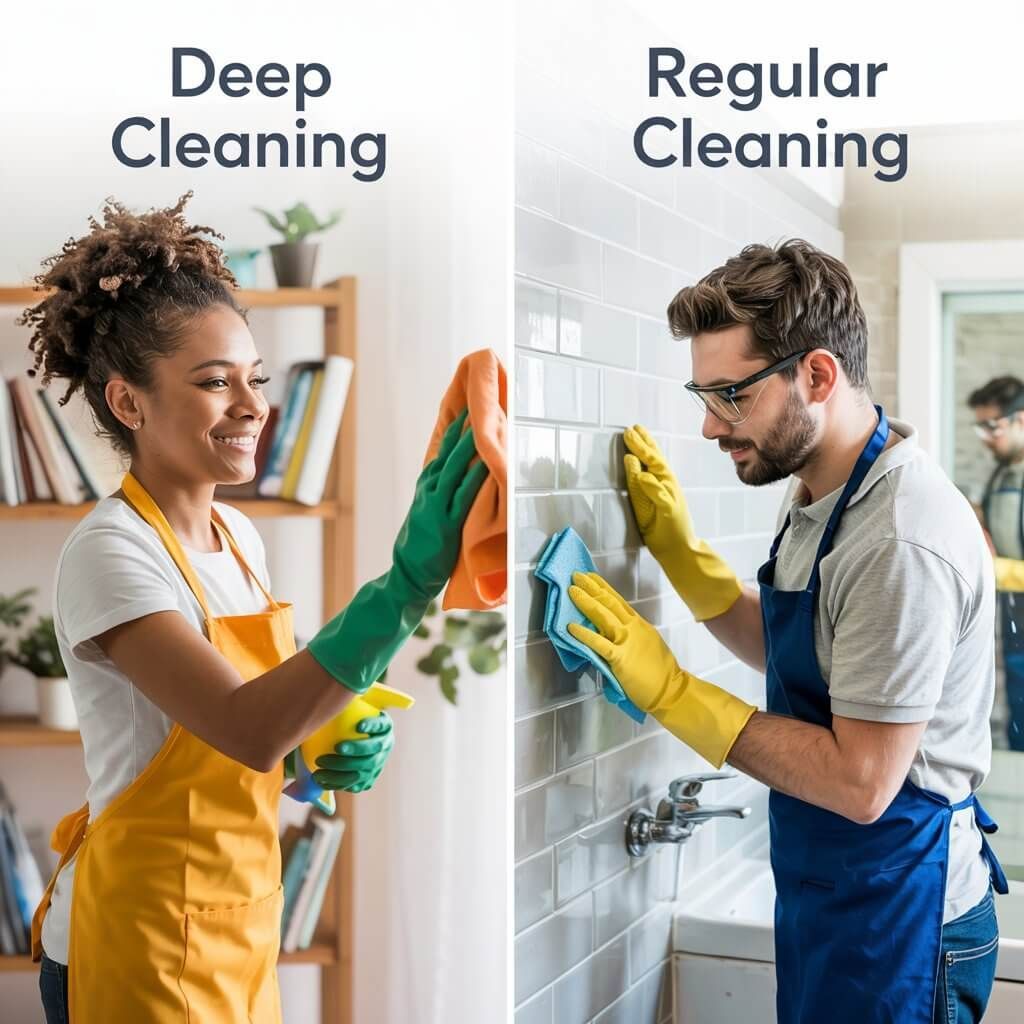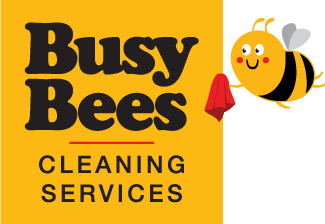How to Identify When Your Office Needs a Deep Clean: Signs You Shouldn't Ignore
First impressions matter in business. When clients or partners step into your office, the cleanliness of your space speaks volumes about your company's attention to detail and professionalism.
While regular maintenance cleaning keeps your workspace pre
sentable on the surface, there comes a point when only a professional deep clean can address the accumulated issues that regular cleaning simply cannot tackle.
At Busy Bees, we've been New Zealand's trusted cleaning experts since 1993, and we've seen how even the most meticulously maintained offices eventually require comprehensive deep cleaning.
Understanding when your workspace has reached this point is crucial for maintaining a healthy, productive environment and protecting your business assets.
The difference between standard cleaning and deep cleaning is significant. Regular maintenance addresses surface-level cleanliness—vacuuming carpets, wiping down desks, and emptying bins.
Deep cleaning, however, tackles the embedded dirt, hidden allergens, and accumulated grime that regular cleaning cannot reach.
This thorough process revitalises your office space, improves air quality, and contributes to a healthier workplace overall.
In this guide, we'll share our expertise on identifying the telltale signs that your office requires professional deep cleaning services. From visible indicators to subtle warning signs, you'll learn exactly what to look for and why addressing these issues promptly matters for your business.
Visual Indicators Your Office Needs Deep Cleaning
Even the most diligent regular cleaning regime will eventually reveal its limitations.
Here are the clear visual signals that indicate your office requires professional intervention:
Persistent Dust Despite Regular Cleaning
One of the most reliable indicators that your office needs a deep clean is the presence of stubborn dust that returns quickly after regular cleaning.
This persistent issue often points to deeper problems that standard cleaning procedures cannot address.
Where to look for persistent dust:
- Computer vents and hardware: When dust accumulates in these areas, it not only affects air quality but can significantly reduce the lifespan of your valuable equipment.
- Overheating caused by dust-clogged vents is a leading cause of premature hardware failure.
- Light fixtures and ceiling elements: Look up—dust on light fixtures, ceiling fans, and air vents not only reduces illumination efficiency but can also circulate allergens throughout your office space each time your HVAC system activates.
- High shelving and cabinet tops: These often-overlooked areas become dust reservoirs, releasing particles into the air whenever vibrations occur or air currents change.
- Behind and under furniture: These hidden areas often harbour significant dust accumulation that regular cleaning doesn't reach.
The simple dust test:
Run your finger along the top of door frames, picture frames, or other horizontal surfaces that aren't part of daily cleaning routines.
If you find a noticeable layer of dust, particularly in areas that should have been recently cleaned, it's a strong indication that embedded dust particles throughout your office require professional attention.
Persistent dust isn't merely an aesthetic issue—it significantly impacts indoor air quality and can exacerbate respiratory conditions among your staff.
Research has demonstrated that poor indoor air quality directly affects concentration levels and cognitive performance, potentially reducing workplace productivity by as much as 10%.
When standard cleaning no longer effectively manages dust levels, our professional deep cleaning service addresses the root causes by thoroughly cleaning ventilation systems, using specialised equipment to extract dust from carpets and upholstery, and accessing hard-to-reach areas that harbour accumulated dust.
Carpet and Flooring Warning Signs
Your office flooring endures constant traffic and absorbs considerable dirt, making it one of the first areas to show signs that deep cleaning is necessary.
Carpeted areas:
- Darkened traffic patterns that remain visible after vacuuming
- A dull, matted appearance that persists despite regular maintenance
- Spots and stains that have become permanent fixtures
- Carpeting that feels stiff or crunchy underfoot rather than soft
- Noticeable odours that emerge when humidity levels rise
Hard flooring surfaces:
- Discoloured grout lines between tiles that once were light-coloured
- A sticky or tacky feeling when walking across supposedly clean floors
- Buildup of waxy residue from improper cleaning product usage
- Scratched or dulled appearance on surfaces that should be shiny
- Persistent scuff marks that standard mopping doesn't remove
When your flooring shows these signs, it indicates that dirt and contaminants have penetrated beyond the surface.
This not only affects appearance but can permanently damage expensive flooring materials. Commercial-grade carpeting represents a significant investment, with premature replacement costs that can run into thousands of dollars.
Professional deep cleaning addresses these issues through methods like hot water extraction for carpets, which removes deeply embedded soil, and specialised techniques for hard floors that strip away built-up residue without damaging surfaces.
These processes not only restore appearance but extend the useful life of your flooring investments.
Stains and Marks on Walls and Surfaces
Wall surfaces and vertical elements often reveal telling signs that your office requires more than standard cleaning.
Common office wall issues:
- Fingerprints and handprints around light switches, door handles, and along corridors
- Coffee splashes or food stains in kitchen and break areas
- Scuff marks from furniture or equipment movement
- Discolouration around air vents indicating filtering issues
- Subtle grease buildup in areas near kitchen facilities
Surface problems to monitor:
- Sticky residue on countertops despite regular wiping
- Watermarks or rings on wooden surfaces
- Cloudy appearance on glass partitions or windows after cleaning
- Stubborn stains on workstations that standard cleaning doesn't remove
- Accumulation of dirt in corners, edges and joints of countertops
These visible marks affect more than just aesthetics—they create an impression of neglect that clients and visitors may subconsciously associate with your business practices.
According to research on workplace environments, visual cleanliness directly influences how visitors perceive an organisation's professionalism and attention to detail.
Standard cleaning often merely wipes the surface of these issues, sometimes even spreading contaminants rather than removing them.
Professional deep cleaning addresses the root causes, using specialised solutions that break down stubborn residues without damaging surfaces, and techniques that restore rather than simply maintain.
Many businesses make the mistake of repainting or replacing surfaces when what they really need is professional deep cleaning.
Our team at Busy Bees has saved numerous clients from unnecessary renovation expenses by restoring surfaces to like-new condition through our comprehensive deep cleaning processes.
By addressing these visual indicators promptly with professional deep cleaning, you maintain not only the appearance of your office but protect your investment in the physical workspace.
Regular deep cleaning prevents the need for premature refurbishment or replacement of carpets, furniture, and fixtures—delivering significant cost savings over time.
Health and Wellbeing Signs
While visual indicators provide obvious clues that your office needs deep cleaning, equally important are the subtle signs affecting your team's health and wellbeing.
As New Zealand's trusted cleaning experts since 1993, we've observed how workplace cleanliness directly impacts employee health, productivity, and overall satisfaction.
Increased Employee Sick Days
One of the most telling indicators that your office requires professional deep cleaning is a noticeable uptick in employee illness and absenteeism.
This pattern often emerges gradually but can significantly impact your business operations and bottom line.
Key connections between office cleanliness and absenteeism:
- Shared surfaces in offices can harbour infectious agents for extended periods. Studies have found that viruses can survive on surfaces like doorknobs, light switches, and shared equipment for 24-72 hours, creating continuous exposure risk.
- Office hotspots including kitchen areas, meeting rooms, and communal technology typically contain 400 times more bacteria than toilet seats due to frequent touching and insufficient cleaning.
- Inadequate deep cleaning of ventilation systems allows pathogens to circulate throughout your office space repeatedly, creating cycles of reinfection.
- Carpets and soft furnishings that haven't been professionally deep cleaned can harbour viruses, bacteria, and allergens that continually affect your team's health.
The economic impact of workplace illness extends far beyond sick leave costs. When accounting for reduced productivity, temporary staffing, and project delays, the real cost of absenteeism can reach 2-3 times an employee's daily salary.
For a medium-sized office, this quickly translates to thousands of dollars in lost productivity annually.
Regular surface cleaning addresses day-to-day hygiene but cannot eliminate deeply embedded contaminants.
Professional deep cleaning targets these pathogens at their source, using hospital-grade disinfectants, steam cleaning, and specialised equipment that standard cleaning cannot match.
Our comprehensive approach addresses both obvious and hidden contamination areas, significantly reducing the pathogen load in your workplace.
Allergy and Respiratory Issues in the Workplace
When employees experience increasing respiratory symptoms or allergic reactions while at work, your office environment may be the culprit.
These symptoms often indicate that allergens and irritants have accumulated beyond the reach of regular cleaning protocols.
Common workplace allergens and their hiding places:
- Dust mites: These microscopic creatures thrive in carpeting, upholstered furniture, and fabric partitions, particularly when these items haven't been deep cleaned for extended periods.
- Mould spores: Often hidden in damp areas, air conditioning systems, and even ceiling tiles where condensation may occur, mould produces spores that cause significant respiratory irritation.
- Pollen: Tracked in from outside or entering through ventilation systems, pollen accumulates in carpeting and soft furnishings, affecting sensitive individuals even outside of traditional allergy seasons.
- Pet allergens: Even in offices where pets aren't present, dander can be brought in on employees' clothing and persist in the environment for months without deep cleaning.
Seasonal considerations also play a significant role in workplace allergens.
Spring pollen, summer humidity (encouraging mould growth), autumn leaf mould, and winter dust from heating systems all contribute to the allergen load in your office environment.
Signs your office air quality needs assessment:
- Employees experiencing eye irritation, sneezing, or coughing that improves when they leave the building
- Visible dust in the air when sunlight streams through windows
- Musty or stale odours that persist despite air fresheners
- Black particles collecting on white surfaces, indicating possible mould or ventilation issues
- Humidity problems evidenced by condensation on windows or damp areas
Addressing these issues through professional deep cleaning doesn't just reduce symptoms—it can transform workplace comfort and productivity.
Our comprehensive approach includes thorough cleaning of ventilation systems, deep extraction cleaning of all soft furnishings, and specialised treatment of problem areas to remove allergen reservoirs that standard cleaning cannot reach.
Odours That Won't Disappear
Persistent odours that remain despite regular cleaning represent another clear indicator that your office requires professional deep cleaning intervention.
These lingering smells often signal embedded contaminants that surface cleaning cannot address.
Common causes of persistent office odours:
- Biological sources: Spills absorbed into carpeting or upholstery over time begin to break down, creating persistent odours even after surface cleaning.
- Ventilation issues: HVAC systems that haven't been professionally cleaned can circulate musty odours throughout your entire facility.
- Hidden mould or mildew: Often developing in areas with minor water intrusion or excessive humidity, these fungi create distinctive musty smells that regular cleaning cannot eliminate.
- Embedded food residues: Break rooms and eating areas accumulate food particles in carpeting, furniture, and even wall coverings, creating subtle but persistent odours.
- Trapped odours in soft furnishings: Fabrics naturally absorb environmental odours over time, including cooking smells, cleaning products, and human odours, eventually reaching a point where they require professional intervention.
The distinction between masking odours and eliminating their source is crucial.
Air fresheners, scented cleaners, and odour-neutralising sprays provide temporary relief but allow the underlying causes to persist and often worsen.
These approaches can also add to the chemical burden in your workplace, potentially creating sensitivity issues for some employees.
Professional deep cleaning addresses odours by:
- Identifying and treating the source rather than masking symptoms
- Using enzyme-based cleaners that break down biological odour sources
- Employing hot water extraction that removes deeply embedded contaminants
- Cleaning ventilation systems to prevent odour circulation
- Applying specialised treatments for specific odour types and affected materials
Beyond the immediate discomfort they cause, persistent odours significantly impact how clients and visitors perceive your business.
Research in environmental psychology has established that odours create powerful subconscious impressions, directly affecting perceptions of professionalism, attention to detail, and even trustworthiness.
When clients enter your space, the absence of odours—rather than the presence of pleasant ones—creates the most positive impression.
The presence of these health and wellbeing indicators doesn't simply suggest that deep cleaning would be beneficial—it signals that professional intervention has become necessary for maintaining a healthy, productive workplace.
As New Zealand's commercial cleaning experts, we've helped countless businesses transform problematic environments into spaces that support employee health and showcase company professionalism.
Seasonal Considerations for Office Deep Cleaning
Throughout our 30+ years of experience providing commercial cleaning services across New Zealand, we've observed how seasonal changes significantly impact office cleanliness and the need for professional deep cleaning.
Each season brings unique challenges that can accelerate the deterioration of your office environment if not properly addressed.
Post-Winter Deep Clean Necessities
Winter places particular stress on office environments, creating specific conditions that often necessitate professional deep cleaning once the season ends.
How winter conditions affect office cleanliness:
- Tracked-in debris: Winter weather means more moisture, mud, and salt being tracked into your office space. These contaminants penetrate carpet fibres and porous flooring materials, causing damage that goes beyond surface appearance.
- Heating system residue: After months of continuous use, heating systems redistribute dust and contaminants throughout your office. The combination of dry indoor air and constant heat circulation creates static electricity that causes dust to cling to surfaces more persistently.
- Reduced ventilation: Offices are typically kept closed and tightly sealed during winter months, allowing indoor air pollutants to accumulate without the natural ventilation that might occur in warmer seasons.
- Moisture issues: Condensation from the temperature differential between cold windows and warm interiors can create ideal conditions for mould growth, particularly around window frames and exterior walls.
- Illness residue: Winter's cold and flu season means more pathogens in your office environment, which can persist on surfaces long after employees have recovered.
Key areas requiring post-winter attention:
- Entryway carpeting and mats: These areas absorb the brunt of winter contamination and require deep extraction cleaning to remove embedded salt, dirt, and moisture that can damage fibres and backing materials.
- Ventilation systems: Professional cleaning of ducts, vents, and filters removes accumulated winter dust and prevents its redistribution when cooling systems activate in spring.
- Window treatments: Curtains, blinds, and fabric partitions collect significant dust during winter months when static electricity is higher, requiring professional attention beyond regular dusting.
- Upholstered furniture: These items act as filters, trapping winter contaminants brought in on clothing and requiring deep extraction to restore freshness and extend their useful life.
Pre-Summer Maintenance
As New Zealand transitions to warmer months, different cleaning challenges emerge that signal the need for professional deep cleaning services.
Summer preparation cleaning priorities:
- Air conditioning systems: Before heavy summer use begins, these systems require professional cleaning to prevent the circulation of accumulated dust, mould spores, and allergens. Dirty cooling systems not only distribute contaminants but also operate less efficiently, increasing energy costs.
- Window cleaning: Professional internal and external window cleaning becomes essential before summer, not just for appearance but to maximise natural light and reduce reliance on artificial lighting—potentially creating significant energy savings during longer daylight hours.
- Light fixtures: Dust accumulation on light fixtures becomes more noticeable during summer's stronger natural light. Beyond aesthetics, clean light fixtures operate more efficiently and reduce fire hazards associated with dust buildup on bulbs and electrical components.
- High-touch surfaces: Summer's increased humidity can activate dormant bacteria and viruses on surfaces, making thorough disinfection of all high-touch areas an important part of summer preparation.
Creating a healthier summer working environment:
The transition to summer provides an ideal opportunity to address issues that may have been developing gradually throughout the year.
Professional deep cleaning prepares your office for summer-specific challenges, including:
- Increased pollen counts that can enter through open windows and ventilation systems
- Higher humidity that can activate dormant odours in carpeting and soft furnishings
- More active pest populations requiring thorough cleaning of food service and storage areas
- Potential mould growth in areas with condensation from cooling systems
Many of our clients find that scheduling professional deep cleaning services at seasonal transition points provides optimal results, allowing targeted intervention before minor issues develop into significant problems.
A pre-summer deep clean not only addresses existing issues but creates a foundation for more effective day-to-day maintenance throughout the warmer months.
By recognising these seasonal indicators and incorporating them into your office maintenance planning, you create a healthier, more productive environment year-round while protecting your physical assets from premature deterioration.
At Busy Bees, our expert team tailors seasonal deep cleaning services to address the specific challenges your office faces throughout New Zealand's diverse climate conditions.
The Hidden Areas Often Overlooked
Beyond the visible surfaces and seasonal considerations, truly comprehensive office cleanliness requires attention to areas that often escape notice during regular maintenance.
With our 30 years of commercial cleaning expertise, we've identified several critical zones that frequently signal the need for professional deep cleaning intervention.
Technology and Equipment Cleaning
In today's digital workplace, technology represents both a significant investment and a major cleaning challenge.
These essential tools quickly become reservoirs for contaminants when not properly maintained.
Technology cleaning concerns:
- Keyboards and peripherals: The average office keyboard harbours more bacteria than a toilet seat. Studies have found that keyboards typically contain 3,295 microbes per square inch compared to 49 per square inch on toilet seats. This contamination accumulates gradually through daily use, food particles, and natural oils from hands.
- Telephones and headsets: These items make direct contact with faces and mouths, yet are among the least frequently deep-cleaned items in office environments. The combination of moisture from breath, skin oils, and constant handling creates ideal conditions for bacterial growth.
- Printers and copiers: These devices generate heat and static electricity, attracting and holding dust that can affect both air quality and equipment performance. The interior components gather toner particles and paper dust that standard cleaning cannot address.
- Computer monitors and screens: Beyond the obvious fingerprints and dust, screens develop a subtle film from airborne particles that reduces clarity and can cause eye strain when not properly cleaned.
Signs your technology needs professional attention:
- Sticky or resistant keys on keyboards
- Visible dust in device ventilation ports
- Cloudy or smudged appearance on screens despite regular wiping
- Overheating electronic equipment
- Unusual odours when equipment operates
Professional deep cleaning of technology addresses these issues using specialised techniques and solutions that remove contamination without risking damage to sensitive components.
This process not only improves appearance but also extends equipment lifespan and reduces the risk of performance issues.
Many businesses discover that their technology maintenance budgets decrease significantly after implementing regular professional deep cleaning, with fewer repairs and longer replacement cycles delivering measurable cost savings.
Behind and Under Furniture
The spaces behind, under, and between furniture pieces create cleaning blind spots that regular maintenance typically cannot address.
These hidden areas often reveal the true cleanliness status of your office environment.
The hidden dirt problem:
- Dust accumulation: These protected areas become repositories for dust that eventually circulates through your office environment as furniture is moved or air currents change. This dust often contains allergens including pollen, pet dander, and dust mite waste—all potential respiratory irritants.
- Food particles: Crumbs and food debris inevitably find their way into these spaces, creating potential pest attractions and contributing to odour issues over time.
- Paper fragments and debris: In busy office environments, small items like paper clips, rubber bands, and paper fragments accumulate in hidden areas, creating both cleaning challenges and potential safety hazards.
- Spill residues: Liquid spills often seep under furniture where they're incompletely cleaned, leaving sticky residues that attract and bind with dust to create stubborn contamination.
Health implications of neglected areas:
The consequences of ignoring these hidden spaces extend beyond aesthetics. Accumulated dust and debris contribute to poor indoor air quality, potentially exacerbating respiratory conditions and allergic reactions among staff.
Additionally, these areas can become harbourage zones for pests attracted to food residues and undisturbed environments.
Professional deep cleaning addresses these challenges through:
- Systematic furniture movement and replacement
- Specialised equipment that reaches into typically inaccessible areas
- Comprehensive extraction of accumulated contaminants
- Treatment of residual staining and residues
Businesses are often surprised by the immediate improvement in air quality and overall freshness after their first professional deep cleaning of these hidden areas.
Many report that even long-standing employees notice and comment on the difference.
Ventilation Systems and Air Quality
Perhaps the most critical yet commonly overlooked aspect of office cleanliness is the condition of your ventilation systems.
These essential systems directly impact every aspect of your indoor environment.
Signs your HVAC system needs cleaning:
- Visible dust around air vents: Discoloration or dust accumulation around air outlets indicates that your system is distributing contaminants throughout your space.
- Inconsistent airflow: Areas with noticeably different temperatures or air circulation may signal duct blockages or ventilation issues requiring professional attention.
- Musty odours when systems activate: This distinctive smell typically indicates mould or bacterial growth within the system itself.
- Increased allergy symptoms among staff: Patterns of respiratory irritation that correspond with HVAC operation strongly suggest ventilation contamination issues.
- Dust reappearance shortly after cleaning: When surfaces quickly redevelop dust after cleaning, your ventilation system is likely redistributing contaminants.
The ventilation-workplace health connection:
Your HVAC system circulates the entire volume of air in your office multiple times daily. When these systems harbour contaminants, they essentially function as distribution networks for dust, allergens, mould spores, and bacteria.
This circulation creates a continuous recontamination cycle that standard cleaning cannot interrupt.
Professional ventilation cleaning involves:
Comprehensive inspection of all system components
Removal of accumulated contaminants from ducts and vents
Cleaning and sanitising of coils, drainage systems, and internal components
Treatment to prevent mould and bacterial growth
Air quality testing to verify improvement
The benefits of professional ventilation cleaning extend far beyond improved cleanliness. Businesses frequently report reduced energy costs, as clean systems operate more efficiently, and decreased absenteeism once air quality issues are addressed.
Many are surprised to discover that problems they had attributed to building age or inherent structural issues were actually addressable ventilation cleanliness concerns.
By addressing these typically overlooked areas through professional deep cleaning, you create a truly comprehensive approach to workplace cleanliness.
The combination of visible surface cleaning, attention to seasonal factors, and thorough treatment of hidden areas delivers a workplace environment that supports both health and productivity.
At Busy Bees, our expert commercial cleaning team has the specialised knowledge, equipment, and techniques to address all these areas effectively.
Our comprehensive approach ensures that both obvious and hidden cleanliness issues are resolved, creating a workplace that truly supports your business objectives.
Benefits of Regular Professional Deep Cleaning
When you recognise the signs that your office needs professional deep cleaning and take appropriate action, the benefits extend far beyond immediate appearance.
As New Zealand's trusted cleaning experts since 1993, we've helped countless businesses transform their workspaces through comprehensive deep cleaning programmes. Here are the substantial, measurable benefits you can expect.
Creating a Healthier Workplace
The connection between workspace cleanliness and employee health is well-established through both research and practical experience.
Professional deep cleaning delivers health benefits that surface cleaning alone cannot achieve.
The science behind clean environments and health:
Pathogen reduction: Professional deep cleaning significantly reduces the microbial load in your office environment. While standard cleaning might address surface contaminants, deep cleaning tackles reservoirs of bacteria and viruses that accumulate in carpets, upholstery, and other porous materials.
Allergen elimination: Deep cleaning removes accumulated allergens including dust mite waste, pollen, pet dander, and mould spores that trigger respiratory issues and allergic reactions. These microscopic irritants become deeply embedded in workplace materials and require professional extraction.
Chemical burden reduction: Over time, offices accumulate residues from cleaning products, personal care items, and environmental pollutants. Professional deep cleaning removes these accumulated chemical residues, creating a more neutral environment.
Air quality improvement: Comprehensive deep cleaning, particularly of ventilation systems and soft furnishings, significantly improves indoor air quality by removing sources of airborne contaminants.
Employee productivity gains:
The health benefits of professional deep cleaning translate directly into business advantages.
Our clients consistently report:
- Reduced absenteeism after implementing regular deep cleaning programmes
- Decreased incidents of workplace-spread illnesses
- Improved concentration and cognitive function among employees
- Higher reported workplace satisfaction
- Reduced complaints about environmental factors like odours or air quality
While these benefits might seem difficult to quantify, the measurable impact on operations makes deep cleaning one of the most cost-effective investments in workplace productivity.
Businesses frequently discover that the cost of professional deep cleaning is recovered multiple times over through reduced sick leave, higher productivity, and improved employee retention.
Extending the Life of Office Assets
Beyond health considerations, professional deep cleaning delivers significant financial benefits by protecting and preserving your physical assets.
How deep cleaning preserves your investment:
- Carpeting and flooring: Professional deep cleaning removes abrasive grit and contaminants that wear down carpet fibres and damage flooring surfaces. Regular deep cleaning can extend carpet life by 30-50%, representing significant savings on replacement costs.
- Upholstered furniture: Deep extraction cleaning removes oils, spills, and contaminants that break down fabrics and create permanent staining. This preservation can extend furniture life by years, deferring major capital expenditures.
- Technology and equipment: Dust and contamination contribute significantly to equipment failure. Professional cleaning of both exterior surfaces and accessible internal components reduces failure rates and extends useful life.
- Wall coverings and painted surfaces: Deep cleaning removes accumulated contaminants that can permanently bond with surfaces over time. Regular professional treatment keeps these surfaces fresh and delays the need for repainting or replacement.
Cost analysis perspective:
- The economics of deep cleaning versus replacement presents a compelling case for regular professional service:
- Commercial-grade carpet replacement costs approximately $45-65 per square metre installed, while professional deep cleaning costs roughly $3-5 per square metre.
- Office chairs typically cost $300-800 each to replace, while professional deep cleaning costs $25-40 per chair.
- Repainting office walls costs approximately $30-45 per square metre, while professional wall cleaning costs $2-4 per square metre.
When calculated across your entire office environment, the potential savings from asset preservation through regular deep cleaning represents thousands of dollars annually for even medium-sized offices.
Many of our clients have discovered that implementing a scheduled deep cleaning programme reduces their capital expenditure budgets by 15-25% over a five-year period.
Improving Brand Image and Client Impressions
The psychological impact of workplace cleanliness extends beyond employee experience to shape how clients and visitors perceive your organisation.
This perception directly affects business relationships and opportunities.
The psychology of clean spaces and business perception:
- First impressions form within seconds of entering a space, and environmental factors including cleanliness significantly influence these perceptions.
- Research in environmental psychology demonstrates that cleanliness cues are subconsciously associated with attention to detail, professionalism, and operational excellence.
- People instinctively connect environmental cleanliness with trustworthiness and competence—critical factors in business relationships.
- Clean, fresh-smelling environments create positive emotional associations that influence decision-making processes.
Areas that clients notice most:
Through our decades of commercial cleaning experience, we've identified the critical areas that most strongly influence visitor perceptions:
- Reception and waiting areas: These create crucial first impressions and set expectations for the entire organisation.
- Client meeting spaces: The cleanliness of these areas directly affects how professional discussions are perceived.
- Restroom facilities: These private spaces strongly influence overall cleanliness perceptions, often disproportionately to their size.
- Common pathways: The routes visitors take through your facility receive particular scrutiny and influence overall impressions.
- Employee workspaces visible to visitors: These areas are seen as reflecting your operational standards and attention to detail.
Professional deep cleaning addresses these high-impact areas with particular attention, ensuring they not only appear clean but are hygienically clean at a microscopic level.
The result is an environment that genuinely reflects your business values and operational excellence.
Transformation stories:
One of our long-standing clients, a professional services firm in Auckland, reported that after implementing quarterly deep cleaning, their client feedback scores regarding "professionalism of facilities" increased by 32%.
Another client in the healthcare sector found that patient satisfaction with "facility cleanliness" rose from 76% to 94% after switching to our comprehensive deep cleaning programme.
These experiences reflect a consistent pattern we've observed over our 30 years of service: investments in professional deep cleaning deliver measurable returns through enhanced brand perception and client confidence.
By understanding the comprehensive benefits of professional deep cleaning—from health improvements to asset preservation to brand enhancement—you can make informed decisions about implementing these services in your organisation.
At Busy Bees, our expert team creates customised deep cleaning programmes that address your specific needs and deliver maximum value across all these dimensions.
Conclusion
Throughout this guide, we've explored the key indicators that signal when your office requires more than regular maintenance cleaning.
From visual cues like persistent dust and carpet discoloration to health indicators such as increased employee illness and allergy symptoms, these signs provide valuable warnings that shouldn't be ignored.
Identifying these signals early allows you to address developing issues before they impact your business operations, employee health, or client impressions.
Professional deep cleaning represents a proactive approach to workplace maintenance that delivers significant returns across multiple dimensions.

